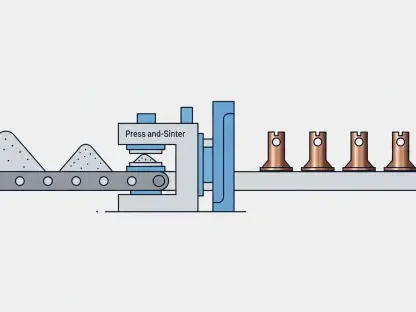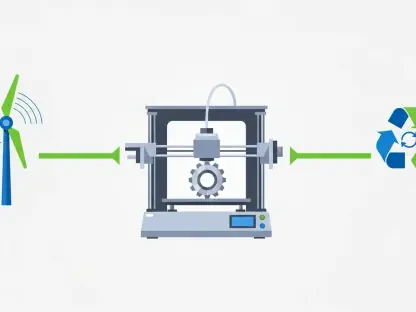Industrial inventory management is evolving significantly with AI-driven advancements, ushering in an era where data-driven decision-making and risk assessment are paramount. Cutting-edge AI solutions like Verusen’s new product for MRO optimization are transforming traditional inventory practices in the industrial and manufacturing sectors, addressing inefficiencies and optimizing operations. This article delves into how such innovations are revolutionizing inventory management, ultimately enhancing operational performance and economic outcomes.
The Importance of AI in Inventory Management
Enhancing Data Management Capabilities
Industrial companies often grapple with disorganized data, which hampers effective inventory management. This issue is pervasive, leading to challenges in tracking and managing inventory effectively. AI technologies can efficiently clean and organize data, providing a solid foundation for informed decision-making. By automating data management, businesses can gain better insights into their inventory, leading to more strategic purchasing and stocking decisions. This data transformation enables companies to move from reactive to proactive management, shifting from crisis management to strategic planning.
Improving data management capabilities also significantly impacts transparency within the supply chain. When data is clean and well-organized, it becomes easier to trace the flow of materials and components, ensuring that all parts of the supply chain are in sync. This interconnectedness is crucial for mitigating risks and responding swiftly to any potential issues. In essence, AI-driven data management lays the groundwork for a more resilient and responsive inventory system, where every decision is backed by real-time, accurate information.
Real-Time Decision Making
AI solutions offer the unparalleled ability to make real-time, data-driven decisions about inventory. By continuously evaluating the criticality of spare parts, these systems can prioritize the availability of essential components. This real-time monitoring is crucial in minimizing downtime and ensuring operational continuity. The shift from periodic reviews to continuous assessment allows organizations to preemptively address potential issues before they escalate into significant disruptions. This proactive approach helps maintain uninterrupted production schedules, which is vital for meeting client expectations and maintaining a competitive advantage.
Moreover, real-time decision-making capabilities extend beyond immediate inventory concerns. By integrating AI into broader operational strategies, companies can align their maintenance, procurement, and production processes more seamlessly. For instance, predictive analytics can forecast future inventory needs based on historical data and current trends, ensuring that businesses are always prepared for fluctuations in demand. This integration not only enhances efficiency but also provides a robust framework for long-term strategic planning, positioning companies to better navigate the complexities of industrial operations.
Addressing Operational Risks
Reducing Downtime and Improving Uptime
One of the most significant advantages of integrating AI into inventory management is its potential to reduce operational risks. AI solutions like Verusen’s evaluate spare part criticality, ensuring that essential components are always available when needed. This capability is crucial for minimizing downtime and keeping production lines running smoothly, which is essential for meeting deadlines and maintaining customer satisfaction. By predicting when and where spare parts will be needed, AI helps avert the costly interruptions that can occur when critical items are out of stock.
Enhancing uptime through AI doesn’t just improve immediate operational metrics; it also has profound implications for broader business performance. Reduced downtime means that assets are utilized more efficiently, leading to higher overall productivity. This improvement translates into better financial results and strengthens the company’s competitive position in the market. Furthermore, by ensuring consistent operational performance, companies can foster stronger relationships with their customers, who can rely on timely deliveries and consistent product quality.
Enhancing Maintenance Operations
AI-driven MRO solutions also bridge the gap between inventory management and maintenance operations. By linking criticality assessments with preventive maintenance schedules, organizations can better plan for repairs and avoid unexpected failures. This alignment ensures that inventory and maintenance strategies work in concert to optimize performance. With AI, maintenance can be scheduled around critical inventory levels, ensuring that parts are available precisely when they are needed for repairs, thus avoiding the delays associated with parts procurement.
This holistic approach to inventory and maintenance management extends beyond immediate operational benefits. By integrating AI, companies can create a more resilient operational framework that is better equipped to handle unforeseen challenges. Predictive maintenance driven by AI not only reduces the frequency of unexpected breakdowns but also extends the lifespan of critical assets, providing long-term value. Through continuous monitoring and analysis, AI-driven systems can identify patterns that might indicate future issues, allowing companies to address them proactively. This capability enhances overall operational stability and reduces the risk of unexpected costs associated with emergency repairs.
Economic Advantages of AI Innovations
Cost Reduction
Implementing AI in inventory management can lead to substantial cost savings, a fact underscored by various industry studies and real-world applications. By evaluating spare part criticality and optimizing stock levels, organizations can reduce excess inventory and avoid unnecessary expenditures. Verusen’s solution, for instance, has been shown to decrease inventory spending by up to 45%, translating to significant financial benefits. This reduction is achieved by ensuring that only the necessary stock is maintained, thereby cutting down on carrying costs and freeing up capital for other vital areas.
Reducing costs through improved inventory management also provides a financial buffer that can be reinvested into further technological advancements or expansion initiatives. For many companies, inventory represents a substantial portion of working capital. Minimizing tied-up capital in inventory through AI optimization allows businesses to allocate resources more efficiently, driving overall financial health and enabling more aggressive growth strategies. The cost savings generated can also be channeled into enhancing other operational areas, further amplifying the positive impact of AI integration.
Financial Impact on Large-Scale Operations
For large industrial companies, the financial advantages of AI-driven inventory management are even more pronounced. Operational cost savings can range from $50 million to $190 million, depending on the scale and nature of the business. These savings not only improve the bottom line but also provide the financial flexibility to invest in further innovations and improvements. By adopting AI solutions, large-scale operations can unlock significant efficiencies that smaller incremental changes might not achieve, underscoring the transformative potential of AI at scale.
Moreover, the financial impact extends beyond direct cost savings. Improved inventory management can lead to better pricing strategies, enhanced supplier negotiations, and more accurate forecasting, all of which contribute to a stronger financial position. With AI-driven insights, companies can negotiate better terms with suppliers based on accurate demand forecasts and reduce the need for emergency procurement, which often comes at a premium. This financial robustness also makes large organizations more resilient to market fluctuations, positioning them to weather economic downturns more effectively. Ultimately, the integration of AI in inventory management not only drives immediate cost benefits but also builds a stronger foundation for long-term financial stability and growth.
Strategic Implementation of AI Solutions
Linking Inventory and Procurement Strategies
Aligning inventory management with procurement strategies is crucial for maximizing the benefits of AI solutions. By integrating AI-driven criticality assessments with procurement processes, organizations can ensure that they are purchasing the right parts at the right time. This strategic alignment leads to more efficient use of resources and better overall inventory management. When inventory and procurement are synchronized, it ensures that purchasing decisions are informed by real-time data on inventory levels and criticality, reducing the risk of over or under-stocking.
This alignment also facilitates more strategic supplier relationships. With accurate and timely information on inventory needs, companies can engage in more collaborative planning with their suppliers, leading to mutually beneficial arrangements. Suppliers can better plan their production schedules and deliveries, knowing precisely when and what the customer will require. This collaboration can result in better pricing, improved lead times, and increased reliability, ultimately strengthening the entire supply chain. By linking inventory and procurement strategies through AI, companies can create a more responsive and resilient supply chain framework.
Harmonizing Supply Chain Operations
AI solutions play a pivotal role in harmonizing supply chain operations by providing real-time insights into inventory levels and criticality. These insights help organizations streamline their supply chains by reducing lead times and improving overall efficiency. When all elements of the supply chain are aligned through AI-driven data, it becomes possible to optimize each link, ensuring that production, inventory, and distribution operate seamlessly. This holistic approach ensures that supply chain disruptions are minimized, and any issues that do arise can be addressed promptly and effectively.
Harmonizing supply chain operations extends to better coordination across various departments within the organization. AI can bridge the gap between siloed operations, creating a unified view of inventory that is accessible to all relevant stakeholders. This connectivity ensures that everyone, from procurement to production to sales, is working from the same set of accurate data. The result is a more integrated and efficient operation where each department’s actions are informed by and aligned with the broader organizational strategy. By integrating AI into supply chain operations, companies can enhance collaboration, reduce inefficiencies, and create a more agile and responsive organizational structure.
Industry Challenges and Solutions
Overcoming Messy Data
One of the primary challenges in industrial inventory management is dealing with messy and unstructured data. AI technologies are adept at cleaning, organizing, and analyzing data, making it more actionable. The ability of AI to handle vast amounts of data efficiently ensures that organizations can rely on accurate and timely information for their decision-making processes. By addressing the issue of messy data, AI helps improve inventory accuracy, allowing companies to maintain optimal stock levels and avoid the pitfalls of over- or under-stocking.
Overcoming data challenges also enhances the predictability and reliability of inventory management systems. With clean and well-organized data, AI can more accurately forecast future inventory needs, identify trends, and detect anomalies. This foresight empowers organizations to anticipate and respond to changes in demand more effectively, reducing the risk of stockouts or excess inventory. Additionally, by maintaining accurate and up-to-date inventory records, companies can improve their regulatory compliance and reporting processes. In this way, AI not only resolves immediate data issues but also contributes to a more reliable and efficient overall inventory management system.
Importance of Asset Criticality
Despite its significance, many organizations neglect the assessment of asset criticality in their inventory planning. This oversight can lead to catastrophic operational failures, as vital components may not be readily available when needed. AI solutions bring criticality to the forefront, ensuring that essential parts are prioritized and readily available. By evaluating the importance of each asset and its impact on operations, AI helps organizations develop more effective inventory strategies that minimize risks and enhance operational efficiency.
Recognizing asset criticality also facilitates better resource allocation and planning. By understanding which assets are most critical to their operations, companies can prioritize their maintenance efforts and allocate resources more effectively. This prioritization ensures that the most vital components are always in optimal condition, reducing the likelihood of unexpected breakdowns and their associated costs. Furthermore, by integrating criticality assessments into their inventory planning, organizations can develop more robust contingency plans, ensuring that they are prepared for any eventualities. In this way, AI-driven criticality assessments not only improve immediate operational performance but also contribute to a more resilient and prepared organization.
Survey Insights and Industry Trends
Current State of Asset Criticality in Inventory Planning
A recent survey by Verusen reveals that nearly 46% of organizations fail to integrate asset criticality into their inventory planning. This significant gap highlights the urgent need for AI solutions that can address this issue. By incorporating criticality assessments, organizations can make better decisions and avoid potential operational disruptions. The survey underscores the prevalent challenges faced by many organizations, emphasizing the importance of adopting advanced AI technologies to bridge the gap and enhance inventory planning.
The survey findings also reflect broader industry trends towards increased reliance on data-driven decision-making. As organizations recognize the limitations of traditional inventory management practices, there is a growing awareness of the need for more sophisticated tools and approaches. AI-driven solutions offer a way to navigate these complexities, providing the insights and capabilities needed to enhance efficiency, reduce risks, and improve overall performance. By addressing the shortcomings identified in the survey, AI technologies can help organizations stay ahead of the curve and maintain a competitive edge in an increasingly dynamic industrial landscape.
The Growing Role of AI in Industrial Operations
As industries continue to evolve, the integration of AI into traditional processes is becoming increasingly crucial. AI-driven innovations are not only enhancing inventory management but also transforming the way organizations approach maintenance, procurement, and supply chain operations. This trend is set to redefine operational norms and establish new benchmarks for efficiency and risk management. The growing role of AI in industrial operations is a testament to its potential to revolutionize traditional practices and drive long-term growth.
The expanding application of AI aligns with broader technological trends shaping the future of industrial operations. As organizations embrace digital transformation, AI stands out as a key enabler of smarter, more responsive, and efficient systems. The adoption of AI is also being driven by the need for greater agility in responding to market changes and operational challenges. By leveraging AI-driven insights and capabilities, companies can create more adaptive and resilient operations, positioning themselves for sustained success in an ever-changing industrial landscape.
Future Prospects of AI in Inventory Management
Continuous Improvement and Innovation
The world of industrial inventory management is undergoing a profound transformation thanks to AI-driven advancements. These innovations are ushering in an era where decisions based on data and risk evaluations are crucial. Leading the charge is Verusen’s innovative product for MRO (Maintenance, Repair, and Overhaul) optimization, which is reshaping the conventional methods of managing inventory in industrial and manufacturing sectors. These advanced AI solutions are tackling inefficiencies and streamlining operations.
Fundamentally, this shift towards AI-enhanced inventory management significantly boosts operational performance and economic results. Traditional practices are becoming obsolete as data-driven techniques take precedence, leading to more accurate forecasting and inventory control. This evolution not only mitigates risk but also enhances efficiency, ensuring that resources are utilized optimally and waste is minimized. As companies increasingly adopt these AI tools, they are better positioned to navigate the complexities of inventory management, thus maintaining a competitive edge in the market.









